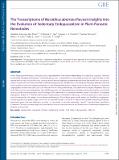Files in this item
The transcriptome of Nacobbus aberrans reveals insights into the evolution of sedentary endoparasitism in plant-parasitic nematodes
Item metadata
| dc.contributor.author | Eves-van den Akker, Sebastian | |
| dc.contributor.author | Lilley, Catherine J. | |
| dc.contributor.author | Danchin, Etienne G. J. | |
| dc.contributor.author | Rancurel, Corinne | |
| dc.contributor.author | Cock, Peter J. A. | |
| dc.contributor.author | Urwin, Peter E. | |
| dc.contributor.author | Jones, John T. | |
| dc.date.accessioned | 2015-08-24T14:40:01Z | |
| dc.date.available | 2015-08-24T14:40:01Z | |
| dc.date.issued | 2014-09 | |
| dc.identifier | 208026669 | |
| dc.identifier | 7fd259d0-f932-4556-ba56-a4ce65fd3cbf | |
| dc.identifier | 000343249300001 | |
| dc.identifier | 84907572840 | |
| dc.identifier.citation | Eves-van den Akker , S , Lilley , C J , Danchin , E G J , Rancurel , C , Cock , P J A , Urwin , P E & Jones , J T 2014 , ' The transcriptome of Nacobbus aberrans reveals insights into the evolution of sedentary endoparasitism in plant-parasitic nematodes ' , Genome Biology and Evolution , vol. 6 , no. 9 , pp. 2181-2194 . https://doi.org/10.1093/gbe/evu171 | en |
| dc.identifier.issn | 1759-6653 | |
| dc.identifier.uri | https://hdl.handle.net/10023/7317 | |
| dc.description | This work was supported by the Biotechnology and Biological Sciences Research Council and The James Hutton Institute (JHI). The James Hutton Institute receives funding from the Scottish Government. This work benefited from interactions promoted by COST Action project FA 1208 and a JHI training grant. | en |
| dc.description.abstract | Within the phylum Nematoda, plant-parasitism is hypothesized to have arisen independently on at least four occasions. The most economically damaging plant-parasitic nematode species, and consequently the most widely studied, are those that feed as they migrate destructively through host roots causing necrotic lesions (migratory endoparasites) and those that modify host root tissue to create a nutrient sink from which they feed (sedentary endoparasites). The false root-knot nematode Nacobbus aberrans is the only known species to have both migratory endoparasitic and sedentary endoparasitic stages within its life cycle. Moreover, its sedentary stage appears to have characteristics of both the root-knot and the cyst nematodes. We present the first large-scale genetic resource of any false-root knot nematode species. We use RNAseq to describe relative abundance changes in all expressed genes across the life cycle to provide interesting insights into the biology of this nematode as it transitions between modes of parasitism. A multigene phylogenetic analysis of N. aberrans with respect to plant-parasitic nematodes of all groups confirms its proximity to both cyst and root-knot nematodes. We present a transcriptome-wide analysis of both lateral gene transfer events and the effector complement. Comparing parasitism genes of typical root-knot and cyst nematodes to those of N. aberrans has revealed interesting similarities. Importantly, genes that were believed to be either cyst nematode, or root-knot nematode, "specific" have both been identified in N. aberrans. Our results provide insights into the characteristics of a common ancestor and the evolution of sedentary endoparasitism of plants by nematodes. | |
| dc.format.extent | 14 | |
| dc.format.extent | 923752 | |
| dc.language.iso | eng | |
| dc.relation.ispartof | Genome Biology and Evolution | en |
| dc.subject | Plant-parasitic nematode | en |
| dc.subject | RNAseq | en |
| dc.subject | Lateral gene transfer | en |
| dc.subject | Host mimics | en |
| dc.subject | Phylogenetics | en |
| dc.subject | Effectors | en |
| dc.subject | QH301 Biology | en |
| dc.subject.lcc | QH301 | en |
| dc.title | The transcriptome of Nacobbus aberrans reveals insights into the evolution of sedentary endoparasitism in plant-parasitic nematodes | en |
| dc.type | Journal article | en |
| dc.contributor.institution | University of St Andrews. School of Biology | en |
| dc.contributor.institution | University of St Andrews. Biomedical Sciences Research Complex | en |
| dc.identifier.doi | https://doi.org/10.1093/gbe/evu171 | |
| dc.description.status | Peer reviewed | en |
This item appears in the following Collection(s)
Items in the St Andrews Research Repository are protected by copyright, with all rights reserved, unless otherwise indicated.

